Korean Spicy Beef Vegetable Soup (Yukgaejang)
Yukgaejang is a deeply flavorful and comforting spicy Korean beef vegetable soup. My recipe includes step-by-step photos and top tips to make this satisfyingly spicy beef soup more authentic.
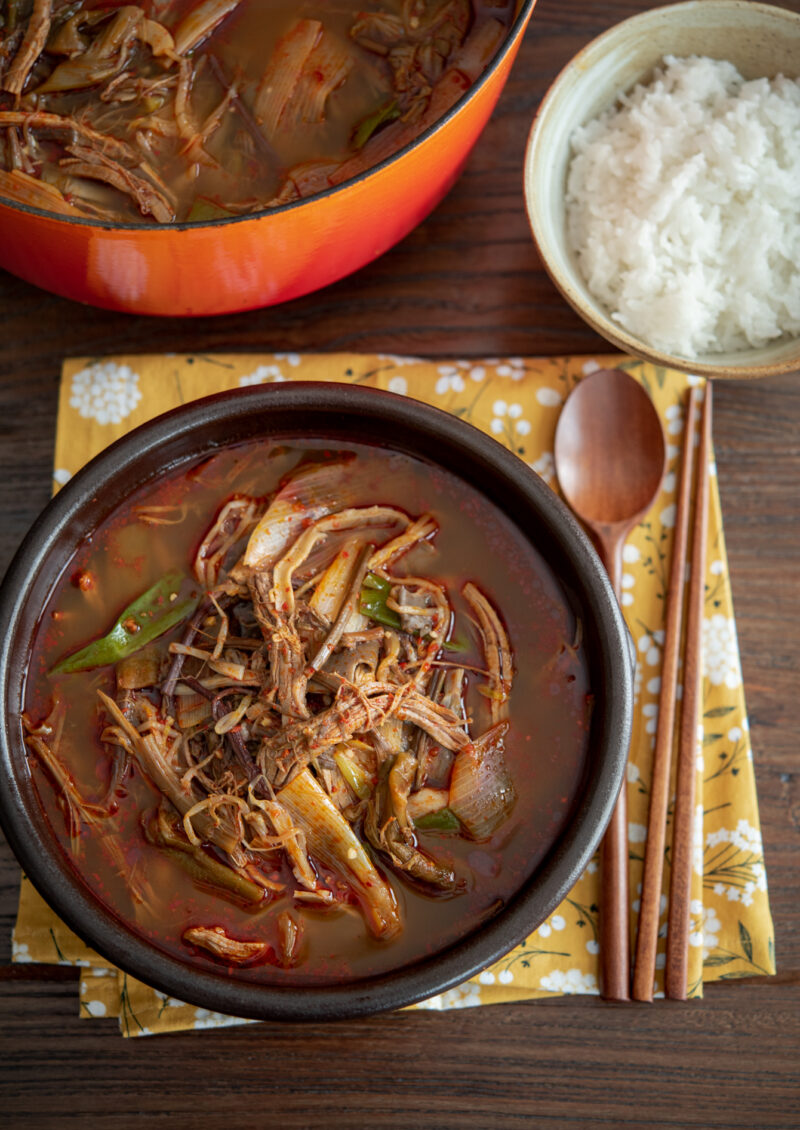
If you like beef soup, and especially if you don’t mind a little spicy kick, don’t miss out on Yukgaejang (육개장), Korean spicy beef vegetable soup recipe. Loaded with shredded beef and variety of vegetables in a flavor packed broth, Yukgaejang is a truly delicious and hearty soup that people crave once they’ve tasted it. Dakgaejang is another similar soup made with chicken, and Dakdoritang is a stew version of Korean spicy chicken recipe.
I have to mention that making Korean beef soup while not complicated, takes time. In fact, you don’t want a quick soup (stew) if you want to taste the deep flavor of this authentic Korean beef soup.
Beef brisket is simmered with onion, garlic, and radish to make the rich broth, and then the meat is shredded. Dry vegetables, such as fernbrake (gosari) and taro stem (toran), are simmered and soaked to re-hydrate. Fresh vegetables are also used to make authentic Yukgaejang.
If you are looking for a quick version, this is not the right recipe. However, this Yukgaejang recipe is not as difficult or complicated as you might think. Just remember my 4 cooking steps prior to making the soup, which I will explain below in the post.
Again, making traditional yukgaejang just takes some time. But it makes a big batch of soup that you can enjoy over and over. Some say it even tastes better on Day Two or Three. So, it’s totally worth the time and effort if you ask me.
Just like any of my authentic Korean recipes, this soup will hit the Korean food cravings you might have. If you are looking for more classic Korean soups and stews, check out my cookbook “Korean Cooking Favorites.”
Fun Fact about Yukgaejang
Do you know that Yukgaejang is one of the most sought-out dishes during the hot summer season in Korea? Interestingly it is a common practice for Koreans to eat really hot soups and stews during the summer to beat the hot weather outside. People believe drinking hot soup strengthens your heat tolerance for the summer. It makes you sweat so much while you are eating, you actually feel cooler to be outside after finishing the soup.
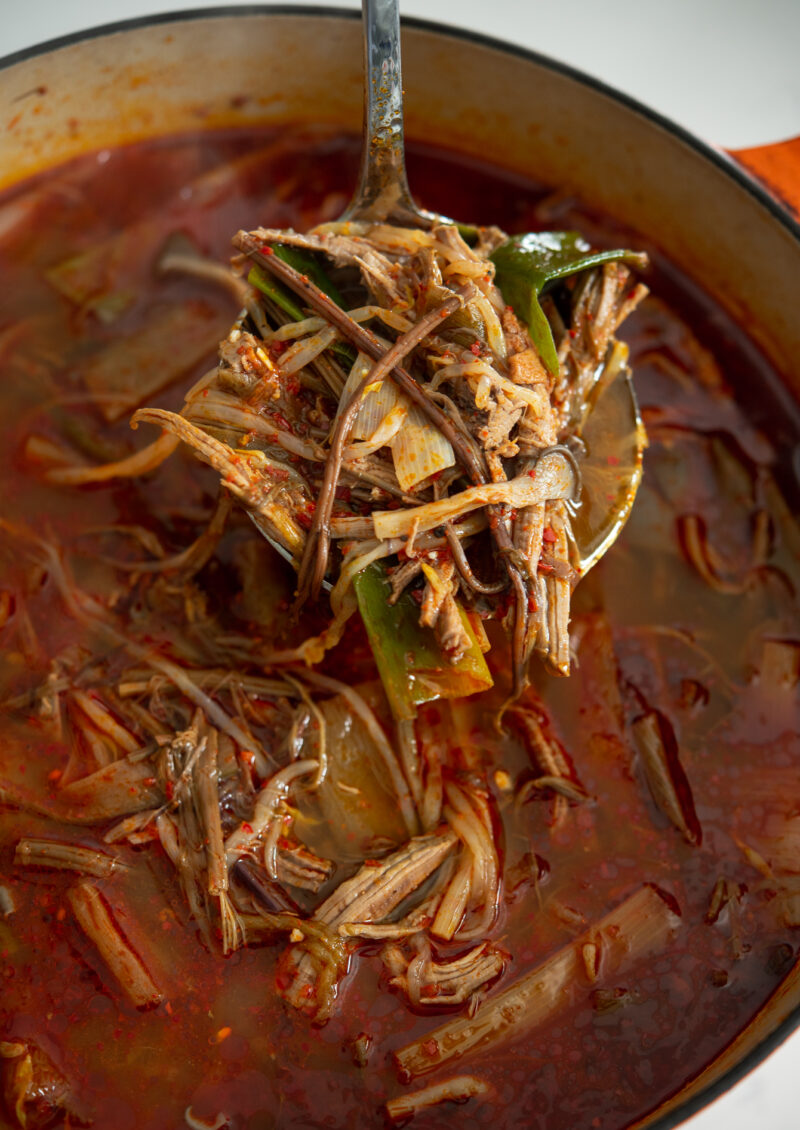
Recipe tips for homemade Yukgaejang
- Boiling Dried Vegetables: Boil dried fernbrake (aka bracken fiddlehead) and taro stem first, then soak them in hot water for 1 hr to re-hydrate.
- Make Beef Stock: Simmer together beef brisket, onion, whole garlic, and radish for 45 minutes to get the rich stock.
- Blanch Fresh Vegetables: Parboil mung bean sprouts, mushrooms, and Asian leeks in boiling water for 60 seconds to get rid of bitterness and sliminess.
- Chili Oil: heat through oil and Korean chili flakes over low heat, then coat the vegetables and beef before you start making the soup.
Once you have done these 4 steps of preparation before you actually make the soup, it only takes about 20 minutes of simmering to complete. Not too bad, right?
Dried vegetables in spicy Korean beef soup
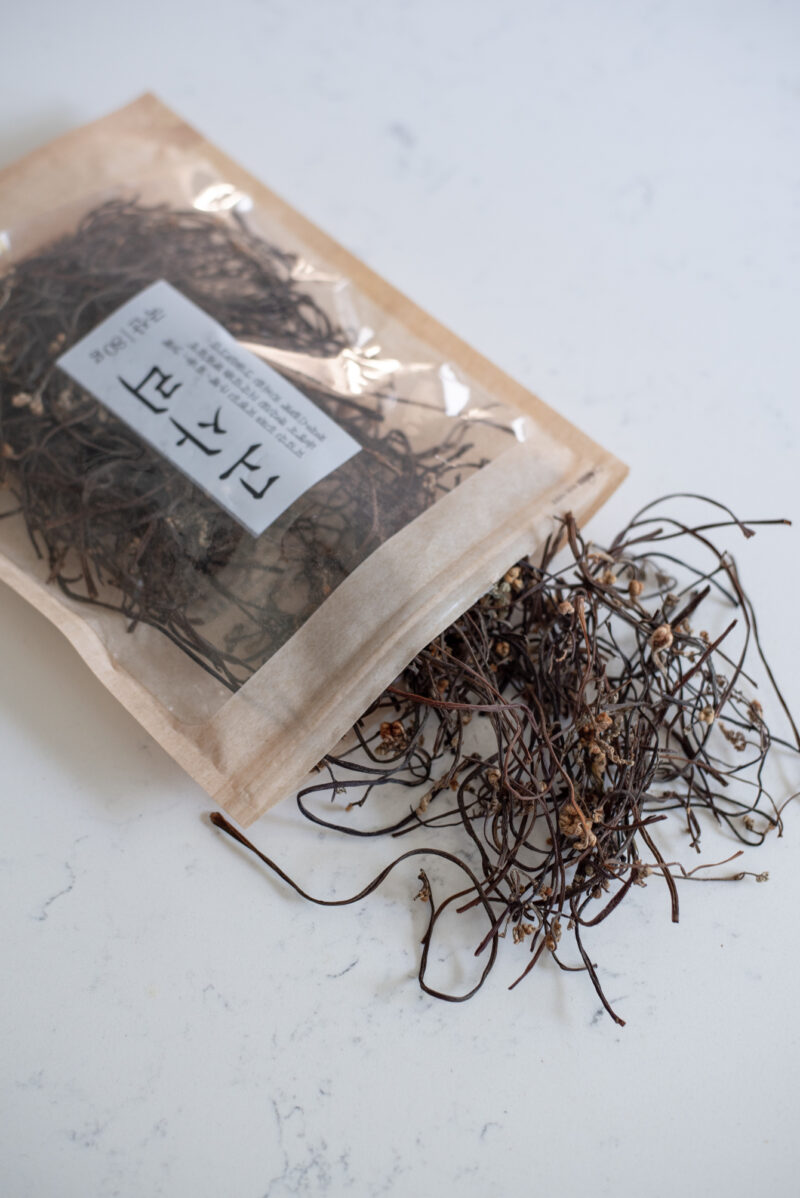
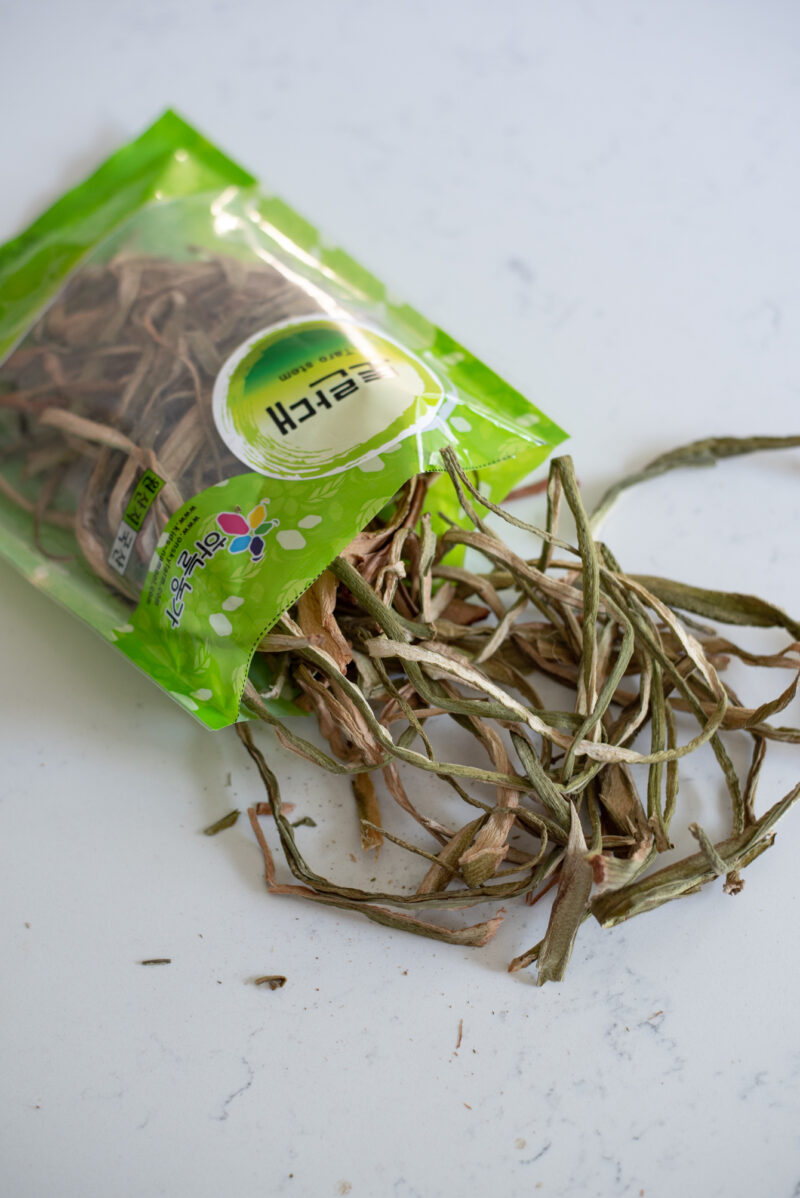
Dried fernbrake (gosari, 고사리) and taro stem (toran, 토란) are easily found in many Korean stores. They have a feather-light weight since they are dried. You only need about half bag of each for this recipe.
In order to re-hydrate, follow these steps. They will quadruple in volume once fully re-hydrated and cooked.
How to re-hydrate the dried vegetables for Yukgaejang
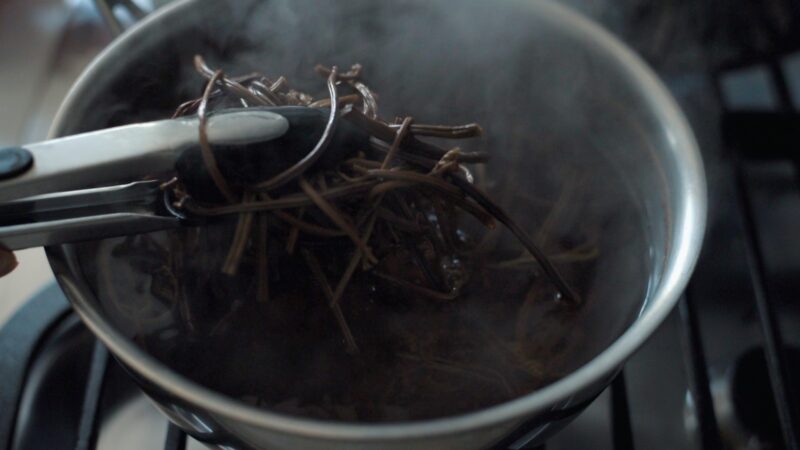
Add a desired amount of ferrnbrake in a pot filled with water. Bring to boil, then simmer for 20 minutes, covered. Remove the pot from heat and let fernbrake soak in the pot for 1 hour, covered.
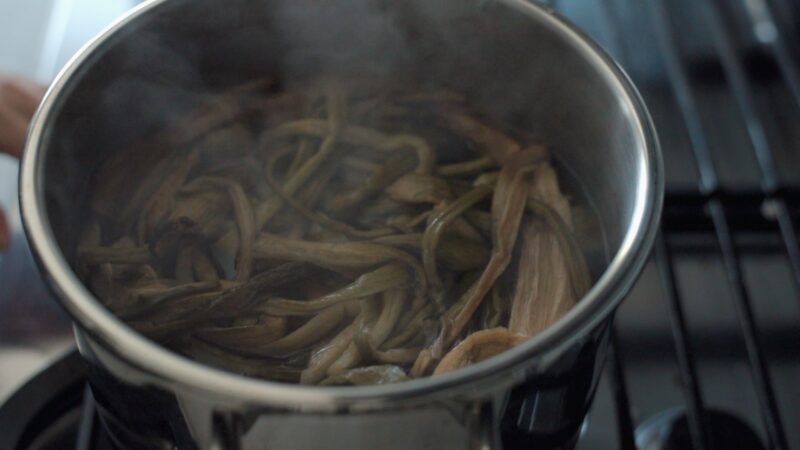
In another pot, cook the taro stem using the same method. Let it soak in the pot for 1 hour as well.
Drain the dried vegetables and rinse them in cold water several times. Squeeze out the extra water from the vegetables.
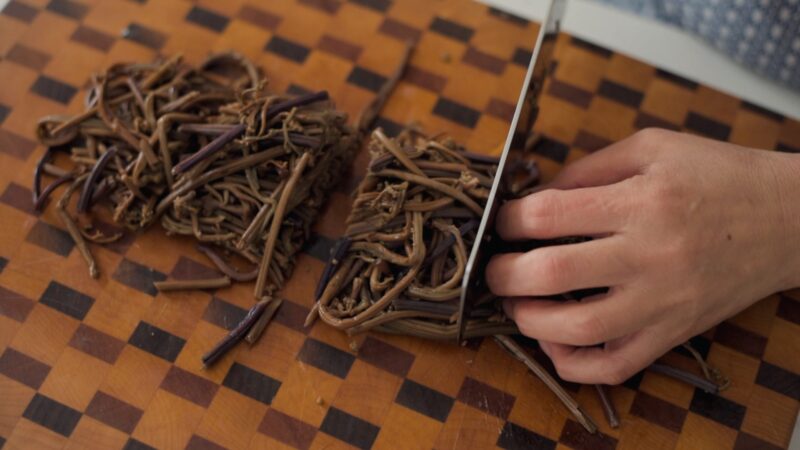
Cut fernbrake and taro stem in 2-inch slices.
Dried Ingredients substitution
Fernbrake and taro stem are hard to substitute with other types of vegetables due to their meaty and chewy texture. However, that doesn’t mean that you can’t make Yukgaeajang without them.
You can use shiitake mushroom in place for fernbrake, and increase the amount of leek and mung bean sprouts for the taro stem.
I have introduced a simpler version of yukgaejang recipe in my “Korean Cooking Favorites” cookbook that doesn’t require these dried vegetables, so check it out.
How to make Korean Beef Vegetable Soup
Step 1. Make beef stock
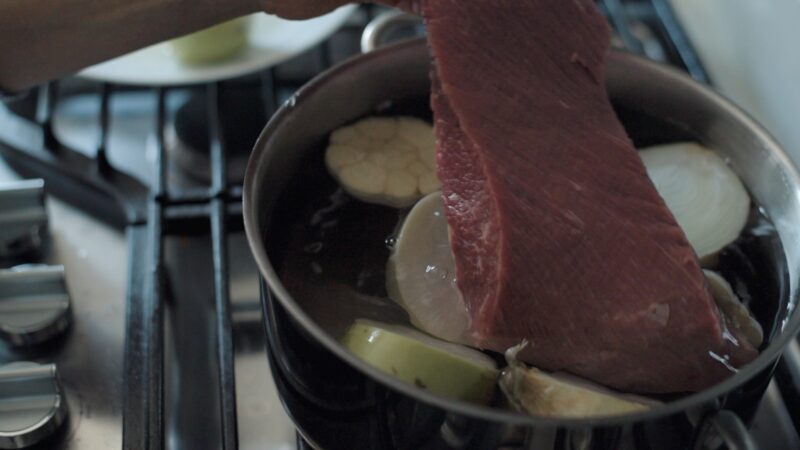
In a stock pot, combine onion, whole garlic (cut in half), chunks of radish and beef brisket. Add 14 cups of water to the pot and bring it to a gentle boil over medium high heat. Reduce the heat to low and let it simmer for 45 minutes.
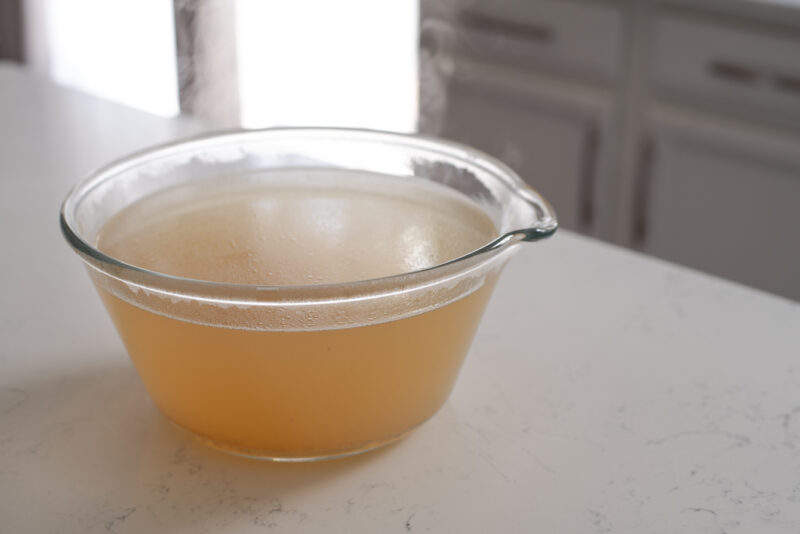
Discard the vegetables and reserve the beef. Strain the stock in a skimmer to collect any small particles. Reserve the stock.
Step 2. Blanch fresh vegetables
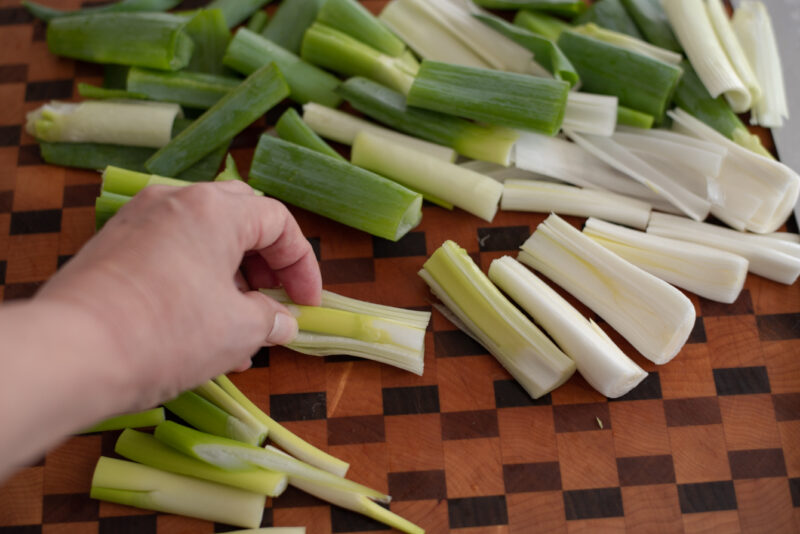
For the Asian leeks, cut them in half lengthwise, then cut into 2-inch slices. As an optional step, remove the pale green core in the center of the white parts of the leeks because they tend to be tough. You can leave it the way it is, if you wish.
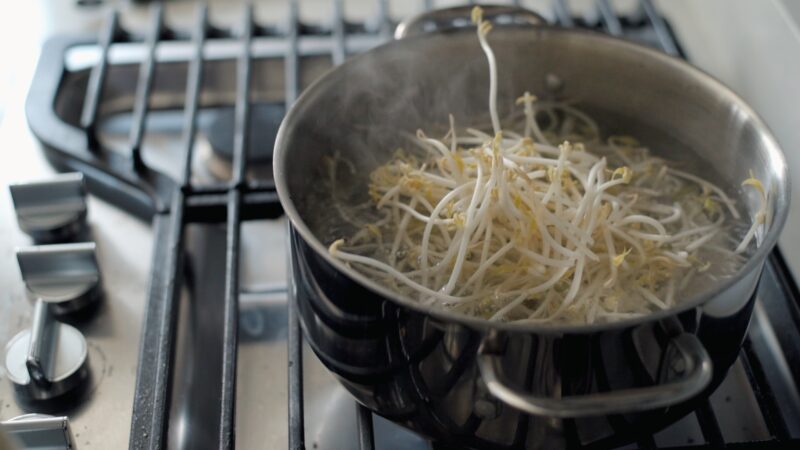
Bring a large pot of water to boil and sprinkle some salt. Add mung bean sprouts, stir, and wait for 10 seconds.
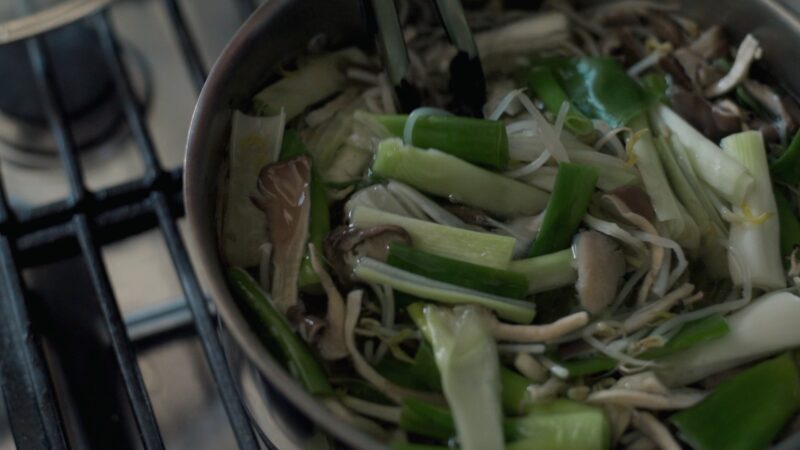
Add oyster mushroom and leek slices. Cook the vegetables for 10 more seconds. Drain and rinse the vegetables in cold running water. Squeeze out the extra water.
Step 3. Shred beef
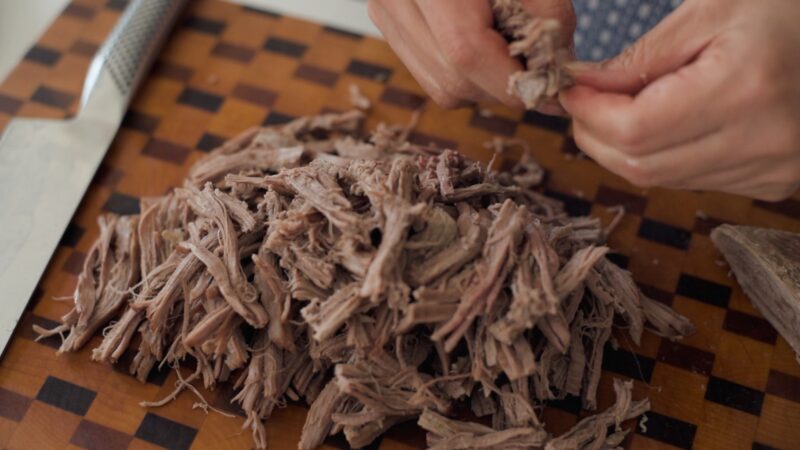
Shred Beef Brisket into bite size pieces.
Step 4. Make a soup with beef and vegetables
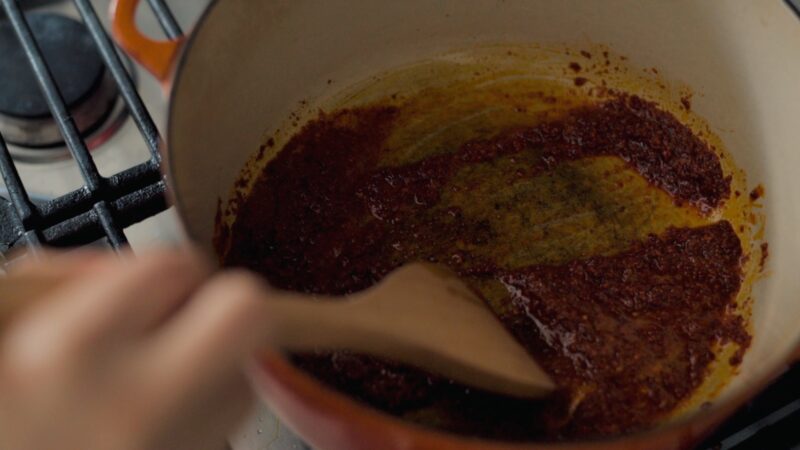
Heat oil and sesame oil in a large pot over low heat. Add the Korean red chili pepper flakes (gochugaru) and stir it for 30 seconds to release the fragrance and infuse the oils.
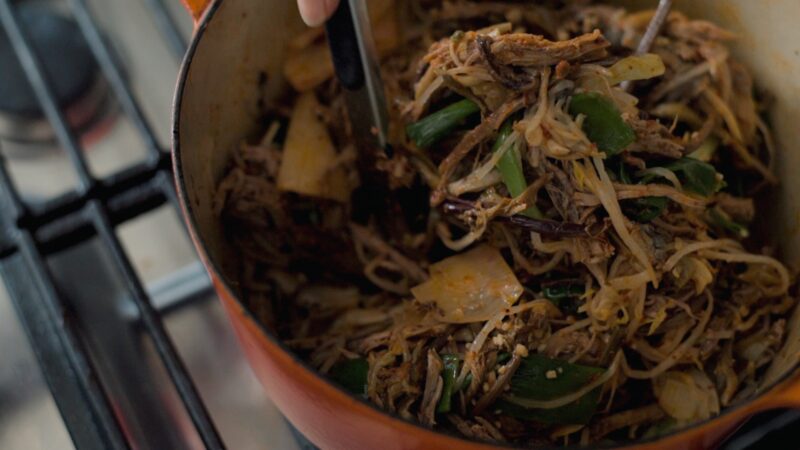
Add the vegetables and beef into the pot. Stir well to coat them with the chili oil.
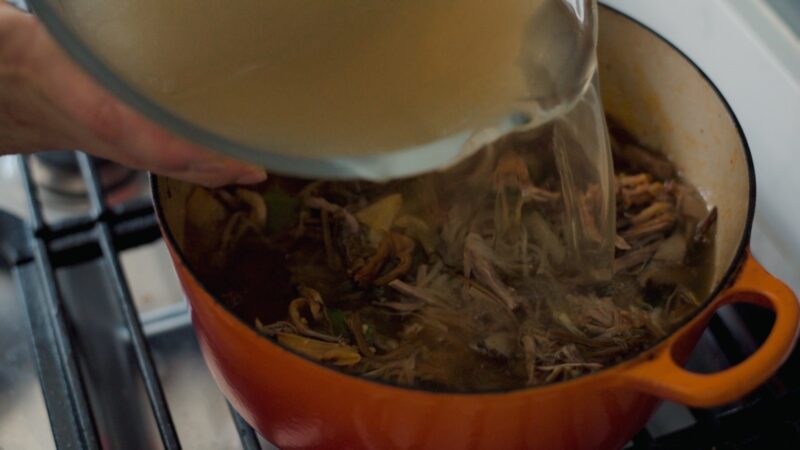
Pour the reserved stock into the pot. The amount of stock could be between 8-10 cups, depending on how thin you want your stew to be.
Step 5. Add flavors
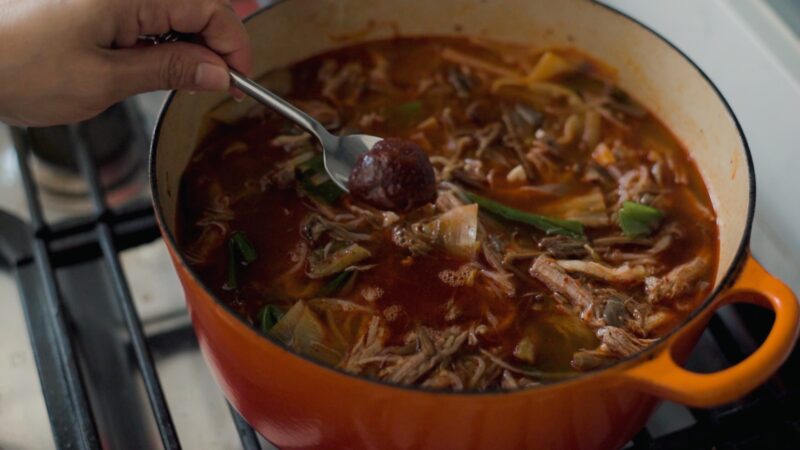
Add a teaspoon of Korean chili paste (gochujang) into the stew and mix well. Chili paste will help your soup to maintain its redness of broth without going dull. Cover the pot and let the stew simmer for 15-20 minutes over med-low heat.
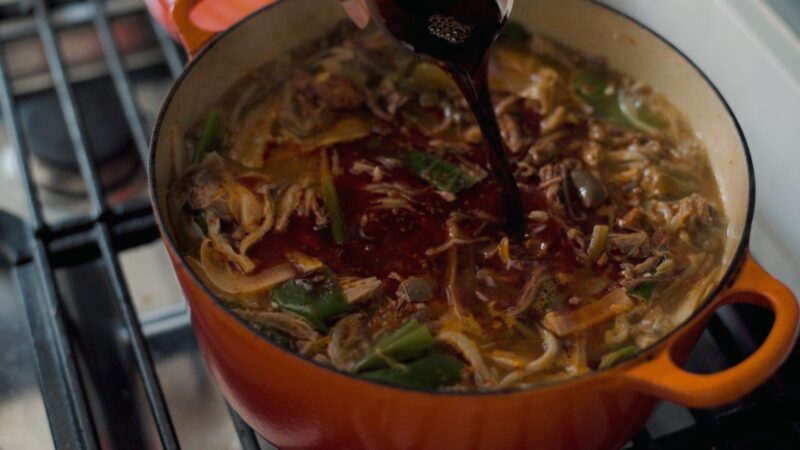
Season the stew with 3 different Korean sauces; soy sauce, Korean soup soy sauce, and Korean anchovy sauce.
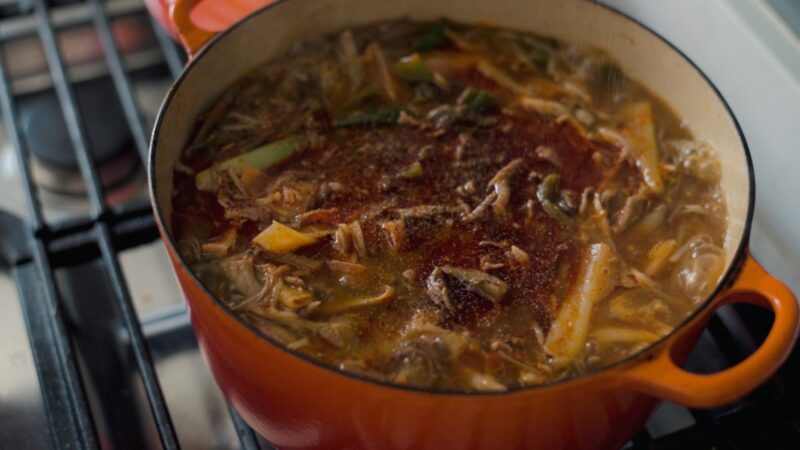
Taste the broth and add some salt, if needed. Lastly sprinkle with lots of black pepper according to your taste.
Serving Suggestion
Serve Yukgaejang hot with a bowl of rice and a simple kimchi. You can sprinkle more black pepper according to your taste.
Storage Tip
You are making a big batch of stew to last for another meal. In fact, the flavor will deepens on the next day. Store any leftovers in the refrigerator up to 1 week. You can also freeze the stew up to 3 months.
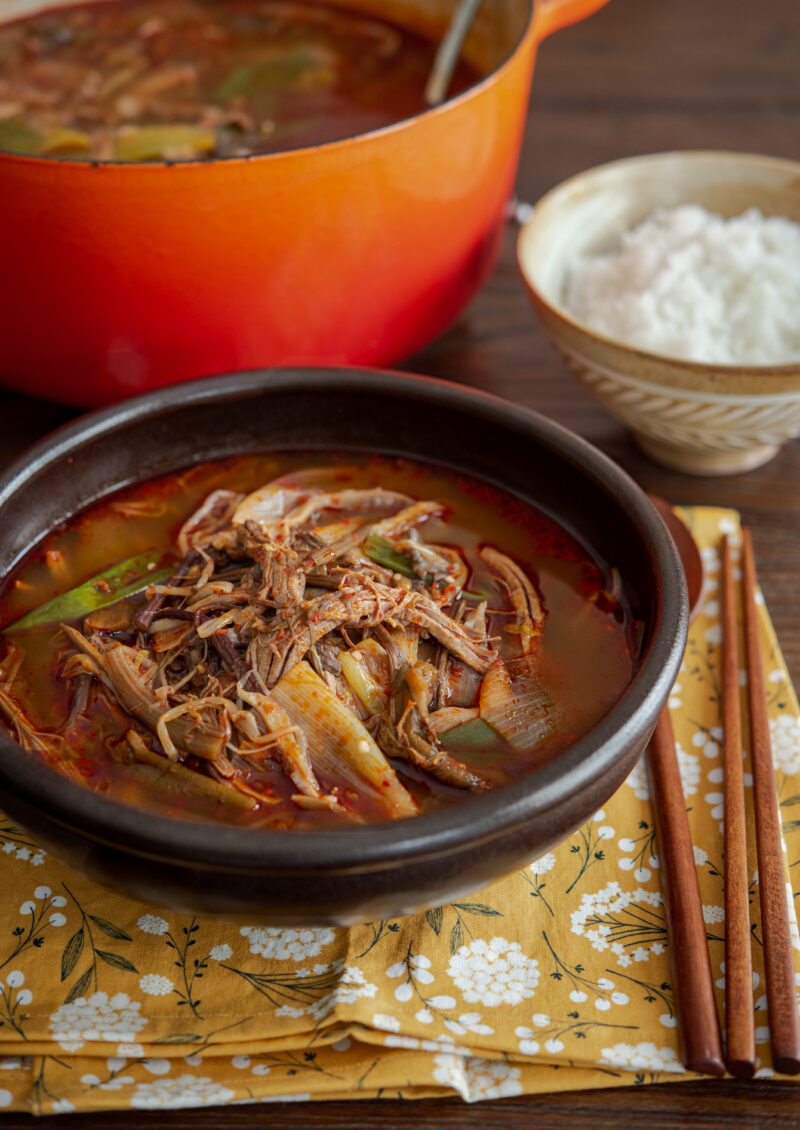
This recipe was originally posted in December 2012. I’ve updated the recipe with a few changes, new photos, and more information.
More Comfort Soups
Soups bring a comfort to our body and mind. Korean soup recipes are not an exception. Here are a few that I love and I hope you will love, too.
- Korean Beef Radish Soup (Sogogi Muguk)
- Spicy Korean Chicken Soup (Dakgaejang)
- Beef and Bean Sprout Soup
- Korean Turnip Green Soup with Potato
- Soybean Sprout Soup with Kimchi
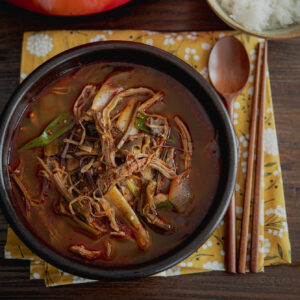
Korean Spicy Beef Vegetable Soup (Yukgaejang)
Recipe Video
Ingredients
For beef soup
- 0.8 oz dried fernbrake
- 1 oz dried taro stem, optional
- 8 oz mungbean sprouts
- 5 oz oyster mushroom, or shiitake mushroom, torn into bite size pieces
- 2 Asian leek
- 3 cloves garlic, minced
- 1 tbsp soy sauce
- 3 tbsp Korean soup soy sauce (gukganjang)
- 1 1/2 tbsp Koran anchovy sauce
- salt and pepper, to taste
For beef stock
- 1 1/4 lb beef brisket
- 1 large onion , cut in half
- 1 whole garlic , cut in half
- 1/2 lb Korean radish, cut into large chunks
- 14 cups water
For chili oil
- 2 tbsp oil
- 2 tbsp sesame oil
- 3-4 tbsp Korean chili flakes (gochugaru)
Equipment
Instructions
To re-hydrate the dried vegetables
- Add fernbrake in a pot filled with water. Bring it to a gentle boil and simmer for 20 minutes. In another pot, cook the taro stem using the same method. Let it soak in the pot for 1 hour as well. Remove each pot from the heat and let vegetables to soak in the pot, covered, for 1 hour.
- Drain the dried vegetables and rinse them in cold water several times. Squeeze out the extra water from the vegetables. Cut fernbrake and taro stem in 2-inch slices.
To make the beef stock
- In a stock pot, combine onion, whole garlic (cut in half), chunks of radish and beef brisket. Add 14 cups of water to the pot and bring it to a gentle boil. Reduce the heat to low and let it simmer for 45 minutes.
- Discard the vegetables and reserve the beef. Strain the stock in a skimmer to collect any small particles. Reserve the stock.
- When the beef is cooled to touch, shred the beef into bite size pieces.
To blanch the fresh vegetables
- For the Asian leeks, cut them in half lengthwise, then cut into 2-inch slices. As an optional step, remove the pale green core in the center of the white parts of the leeks because they tend to be tough. You can leave it the way it is, if you wish.
- Bring a large pot of water to boil and sprinkle some salt. Add mungbean sprouts, stir, and wait for 10 seconds.
- Add oyster mushroom and leek slices. Cook the vegetables for 10 more seconds. Drain and rinse the vegetables in cold running water. Squeeze out the extra water.
To make the beef soup (Yukgaejang)
- Heat oil and sesame oil in a large pot over low heat. Add the Korean chili flakes and stir it for 30 seconds to release the fragrance and infuse the oils.
- Add the vegetables and beef into the pot. Stir well to coat them with the chili oil. Pour the reserved stock into the pot. The amount of stock could be between 8-10 cups, depending on how thin you want your stew to be.
- Add a teaspoon of Korean chili paste (gochujang) into the stew and mix well. Chili paste will help your stew to maintain its redness of broth without going dull. Cover the pot and let the stew simmer for 15-20 minutes over med-low heat.
- Season the stew with 3 different Korean sauces; soy sauce, Korean soup soy sauce, and Korean anchovy sauce. Taste the broth and add some salt, if needed. Lastly sprinkle with lots of black pepper according to your taste.

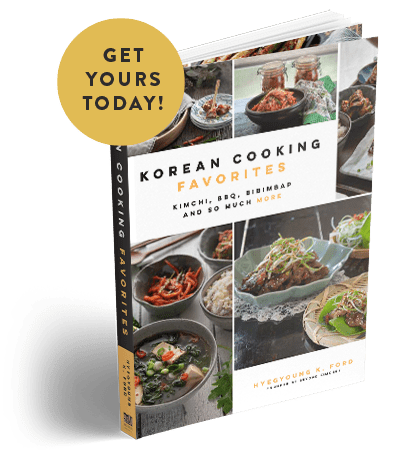
My wife is Korean. She’s been making yukgaejang for 40 years, and this recipe is very close to hers. The only thing wrong with the recipe is its title. If you try saying “yukgaejang” using standard English, it sounds like “yuck-gay-jang” (rhymes with “gang”). Why not use “yook-keh-jahng”? Any grade-school student can say yook-keh-jahng, but you have to learn a new system of pronunciation in order to say yukgaejang correctly. It’s easier to learn hangul than to learn Korean Romanization.
Yook keh jahng? I think the way Holly did it is just fine. That’s the way I spell it
in English too. I definitely would NOT spell it “keh” . It’s more of a g sound than a k sound.
I agree with your comment about the “g” in “geh”, but most Americans will pronounce “yuk” as “yuck”, the word for something distasteful. The general rules of English pronunciation and spelling wouldn’t produce an “oo” sound between “y” and “k” unless there were a silent “e” afterward, as in “juke” and “duke”. And the “ae” spelling will nearly always produce a long “a”, and “jang” will produce a short “a” as in “rang” (My wife’s given name is “Hyang-Jin”, and when she spelled it that way, people invariably said “hyang” to rhyme with “bang”, “sang”, and “gang”. Yukgaejang, for people unfamiliar with the word, will produce yuck-gay-jayng. (In case it isn’t obvious, I seriously disagree with most attempts to Anglicize hangul. It’s much easier to learn hangul — which people often pronounce hang-gull — then to invent a new set of rules for English spelling.)
Wow! Never heard of this dish before, but would love to try. It looks so hearty and comforting and I know hubby and I would enjoy it!
It is a comforting stew, especially for those who loves spicy stews. Tasty!
I’m not familiar with Yukgaejang, but it sounds absolutely fantastic! I love beef stew, and I enjoy spicier cuisine on occasion. I definitely need to try this! Interesting note about eating this on a hot day – I can’t say that it would be my first choice, but I do see the logic. For me, this sounds like an excellent dinner on a chilly Autumn day! Plus, it uses brisket, and I almost always smoke my briskets…fun way to use brisket in a different style.
If you like spicy food, you will definitely love this stew.
I know what you mean. It’ is not my first choice to eat hot soup in the middle of summer heat, either. It is, indeed, a great soup for the cold season, too.
Lots of work…but it turned out looking really tasty and flavourful. So definitely worth all of the efforts!
It takes time, but it’s so worth it. the leftover tastes even better on the next day.
Hi holly, love your recipes! I just got an instant pot (electric pressure cooker) and was wondering if you knew how to cover the cooking times and steps to make this in a pressure cooker instead of on the stove? Thanks!
I would reduce the amount of stock by 2/3, and the reduce the cooking time according to the soup setting.
Hi Holly,
thank you for this recipe. It is a great starting point for me 🙂
I have to nitpick about you bringing up and those taro stems, though…
My mother told me that, originally, taro stems were never used here. It used to be Goguma stems, but unfortunately, they are hardly available anymore – even in Korea (!).
So… the king would probably had had goguma stems. I suppose the story adapts wonderfully 😛
Kind regards
Hi Holly! Been following ur recipes a lot! My household is really small so i wanna ask if i can store this gorgeousness in the fridge or something?
Hi Mion
Yes, you can store the leftover in the fridge and reheat it over the stove or in a microwave. Hope you like it.
Thank u for the reply Holly! May i know how long does it keep?
It will last up to 10 days in the fridge. It might taste good even after, but be cautious.
Thanks for the recipe and story behind yukaejang – very touching! I look forward to trying your recipe – I never knew how to make that “red” soup color; mine is a much more simple version. Thanks for your great blog, recipes, and stories – much more accessible than the Korean cookbook my mom gave me 🙂
I’ve been looking so hard to find a perfect recipe of Yukgaejang. When I first tried this dish at a Korean restaurant, I instantly loved it. So I’m gonna try this soon.. I also told my boyfriend about me trying this recipe so he’s kind of excited as well. 🙂
Hi Isa
Hope you enjoy this recipe. Your boyfriend is a lucky guy! ^^
OMG! This is my favorite Korean soup. I have to try this recipe!! Thank you!
probably my all time favorite korean dish. i could eat this 24/7/365.
Wow, this must be your true love! Thanks for the comment, Erik!
Looks so good, can’t wait to try! I don’t think many people realize how inexpensive these Asian food ingredients can be at Asian markets. Well at least here in San Diego there are many different markets to choose from!
First off, I just want to say that I love your blog, and I have bookmarked it. Your stories and recipes are fantastic! After having spent about 2 hours searching, reading and getting very hungry, this stew looks like the dish I’ll try making first… I LOVE spicy food! 🙂 Having read your entire tutorial on kimchi, I think that might be a bit more than I can handle for the first Korean dish I make. lol This stew looks wonderful, and I have a Korean co-worker I’d love to take some to. In this recipe, you said you substituted oyster mushrooms for the taro stem. I am a cashier at a large Houston grocery store where occasionally I have seen taro stems come through my register. Never knew what they would be used for until now! If in fact I can get my hands on taro stem, how much would I need for this recipe, and how would I prepare it for the stew? Also, is there a substitute for fiddleheads in case I cannot find them?
Hi Rebecca
Thanks for the sweet comment. I am glad that you enjoy reading my post. This particular stew is really great for cold weather days. I hope you get to enjoy making it. It is exciting to hear that you have an access to taro stems. if they are fresh, just blanch in a boiling water until soft, then add to the other mixture for seasoning. If dried, you need to soak overnight and boil in the water until soft.
For the substitution of fiddle head, it is sort of one of the most important ingredient next to the beef, but if you can’t find them, try with swiss chard. Let me know how it turns out.
This looks delicious!
Are the fiddleheads the same as what we get in North America in the spring? http://www.gourmetfury.com/photos/fiddlehead1.png
Not all the fiddleheads are created equal I guess. They look a little different but you can still use them in the recipe.
Thanks so much for this recipe…I’m South Korean myself and adopted, and i love korean food but i’m trying to research myself about korean food since i didn’t have a korean upbringing. I always ordered this dish in restaurants but i didn’t know what the fiddlehead was! i’m going to try and find this at my local asian supermarket now i know what i’m looking for. thanks again for the story and inspiration!
Oh Holly, I love your stories that come with your food! So what happened to the King after he ate his stew and understood the meaning? I will try and find that film, hope I can find a version with Eng subtitles! Lol
The stew looks fabulous and I can’t wait to try it 🙂
Hi Lucy
I think the king died soon after in the movie. But in real history, he lived 10 or more years and secretly supported resistance groups for the country to bring the independence. It is very interesting movie about food and I really enjoyed. Hope you get to find.
Ah… I love yukgaejang and have been patiently waiting for your version, Holly. Can’t wait to make it myself!
Thanks. It was really tasty and spicy! Hope you get to try soon.
I really enjoyed learning about some of the symbolism behind this dish–very interesting and very beautiful. Not to mention that it looks really delicious!
I just finish making this. Soooo good, soooo spicy, I am like your son, needed lots of water but the spiciness just makes you want to eat more, I don’t know if there will be leftovers for tomorrow: )
I’m reading this on a cold winter morning and it looks SO GOOD. Gorgeous recipe and I love the story about your son’s Pakistani friends. Adventurous eaters warm my heart!
Oh boy, does that look delicious! Yukgaejang was my all time favorite dish growing up. When going to Korean BBQ restaurants, I would actually prefer ordering this over galbi even, and nobody ever understood why. I dont get to eat this dish much these days, but I should making your version sometime. Thanks for the recipe.
Hi Mike
I don’t get to eat much of this stew often either. It is good, isn’t it? I love old time favorite food and Yukgaejang is great comfort food for most Koreans. Thanks for your comment.
Great story! And great stew! Good tip on the fiddleheads – I rarely see them in markets here, but didn’t realize they were common in Korean cooking. Now I know where to look. BTW, Pakistani food can sometimes be fiery hot! We used to have a friend who was Pakistan, and we were at her house one day with some other friends who were Indian. Our Indian friends has perspiration beading their foreheads as they were eating lunch because they found the food so hot! My wife and I had no problem. But at the time we were seriously into spicy food. Anyway, good post – thanks.
Thanks Holly for this recipe. I tried following another site’s recipe but it just did not taste right. Can’t wait to try this!